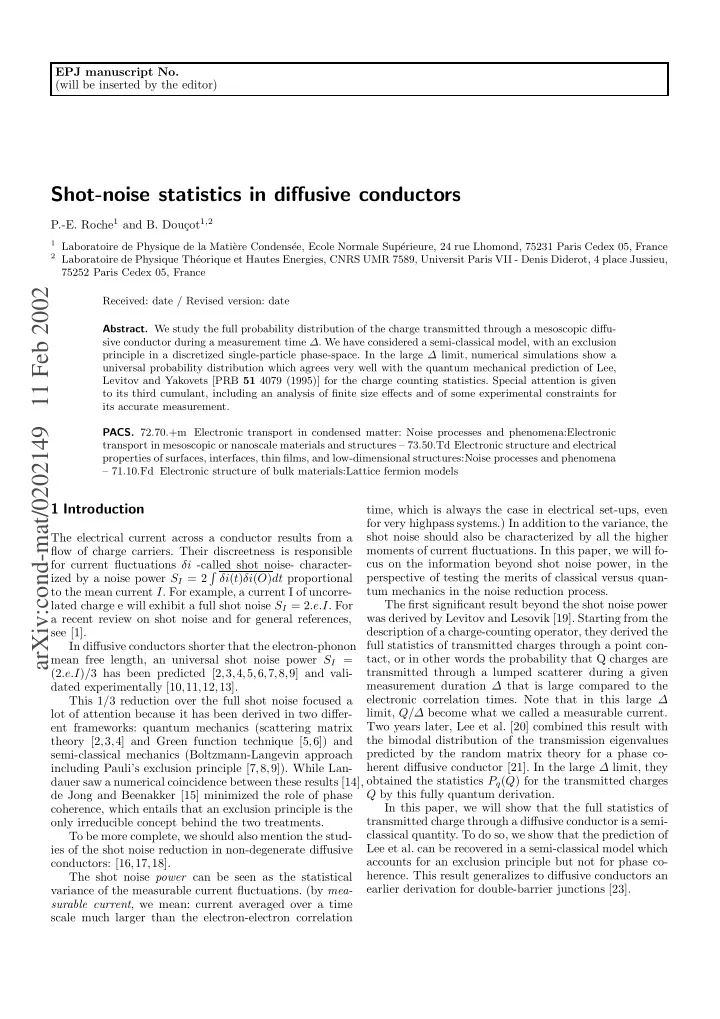

EPJ manuscript No. (will be inserted by the editor) Shot-noise statistics in diffusive conductors P.-E. Roche 1 and B. Dou¸ cot 1 , 2 1 Laboratoire de Physique de la Mati` ere Condens´ ee, Ecole Normale Sup´ erieure, 24 rue Lhomond, 75231 Paris Cedex 05, France 2 Laboratoire de Physique Th´ eorique et Hautes Energies, CNRS UMR 7589, Universit Paris VII - Denis Diderot, 4 place Jussieu, 75252 Paris Cedex 05, France arXiv:cond-mat/0202149 11 Feb 2002 Received: date / Revised version: date Abstract. We study the full probability distribution of the charge transmitted through a mesoscopic diffu- sive conductor during a measurement time ∆ . We have considered a semi-classical model, with an exclusion principle in a discretized single-particle phase-space. In the large ∆ limit, numerical simulations show a universal probability distribution which agrees very well with the quantum mechanical prediction of Lee, Levitov and Yakovets [PRB 51 4079 (1995)] for the charge counting statistics. Special attention is given to its third cumulant, including an analysis of finite size effects and of some experimental constraints for its accurate measurement. PACS. 72.70.+m Electronic transport in condensed matter: Noise processes and phenomena:Electronic transport in mesoscopic or nanoscale materials and structures – 73.50.Td Electronic structure and electrical properties of surfaces, interfaces, thin films, and low-dimensional structures:Noise processes and phenomena – 71.10.Fd Electronic structure of bulk materials:Lattice fermion models 1 Introduction time, which is always the case in electrical set-ups, even for very highpass systems.) In addition to the variance, the The electrical current across a conductor results from a shot noise should also be characterized by all the higher moments of current fluctuations. In this paper, we will fo- flow of charge carriers. Their discreetness is responsible cus on the information beyond shot noise power, in the for current fluctuations δi -called shot noise- character- � perspective of testing the merits of classical versus quan- ized by a noise power S I = 2 δi ( t ) δi ( O ) dt proportional to the mean current I . For example, a current I of uncorre- tum mechanics in the noise reduction process. lated charge e will exhibit a full shot noise S I = 2 .e.I . For The first significant result beyond the shot noise power was derived by Levitov and Lesovik [19]. Starting from the a recent review on shot noise and for general references, description of a charge-counting operator, they derived the see [1]. full statistics of transmitted charges through a point con- In diffusive conductors shorter that the electron-phonon mean free length, an universal shot noise power S I = tact, or in other words the probability that Q charges are transmitted through a lumped scatterer during a given (2 .e.I ) / 3 has been predicted [2,3,4,5,6,7,8,9] and vali- measurement duration ∆ that is large compared to the dated experimentally [10,11,12,13]. electronic correlation times. Note that in this large ∆ This 1 / 3 reduction over the full shot noise focused a limit, Q/∆ become what we called a measurable current. lot of attention because it has been derived in two differ- Two years later, Lee et al. [20] combined this result with ent frameworks: quantum mechanics (scattering matrix the bimodal distribution of the transmission eigenvalues theory [2,3,4] and Green function technique [5,6]) and predicted by the random matrix theory for a phase co- semi-classical mechanics (Boltzmann-Langevin approach herent diffusive conductor [21]. In the large ∆ limit, they including Pauli’s exclusion principle [7,8,9]). While Lan- obtained the statistics P q ( Q ) for the transmitted charges dauer saw a numerical coincidence between these results [14], Q by this fully quantum derivation. de Jong and Beenakker [15] minimized the role of phase In this paper, we will show that the full statistics of coherence, which entails that an exclusion principle is the transmitted charge through a diffusive conductor is a semi- only irreducible concept behind the two treatments. classical quantity. To do so, we show that the prediction of To be more complete, we should also mention the stud- Lee et al. can be recovered in a semi-classical model which ies of the shot noise reduction in non-degenerate diffusive accounts for an exclusion principle but not for phase co- conductors: [16,17,18]. herence. This result generalizes to diffusive conductors an The shot noise power can be seen as the statistical earlier derivation for double-barrier junctions [23]. variance of the measurable current fluctuations. (by mea- surable current , we mean: current averaged over a time scale much larger than the electron-electron correlation
Recommend
More recommend